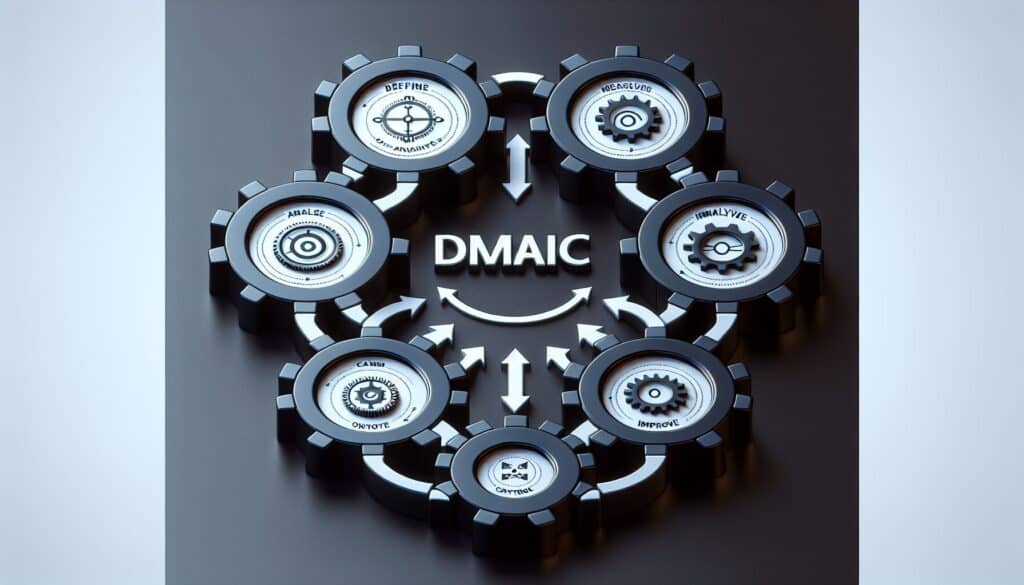DMAIC stands for “Define, Measure, Analyze, Improve and Control“, a famous data-driven, five-phase improvement cycle used in Seis Sigma projects to improve existing processes by identifying and eliminating defects or problems.
- Metodologías: Ingeniería, Calidad
DMAIC

DMAIC
- Mejora continua, Manufactura esbelta, Técnicas de resolución de problemas, Mejora de procesos, Control de calidad, Gestión de calidad, Análisis de causa raíz, Seis Sigma, Control estadístico de procesos (CEP)
Objetivo:
Cómo se utiliza:
- DEFINE: Define the problem, project goals, and customer requirements. MEASURE: Measure current rendimiento del proceso. ANALYZE: Analyze data to identify root causes of defects. IMPROVE: Develop and implement solutions to address root causes. CONTROL: Implement controls to sustain the improvements.
Ventajas
- Provides a structured and rigorous approach to problem-solving; Data-driven, leading to more objective decisions; Focuses on achieving measurable financial or performance improvements; Widely recognized and transferable methodology.
Contras
- Can be lengthy and resource-intensive, especially for complex projects; Requires statistical expertise for effective data analysis; May be overly prescriptive or bureaucratic if not applied flexibly; Focus on existing processes, less so for designing new ones (see DMADV).
Categorías:
- Lean Sigma, Fabricación, Resolución de problemas, Gestión de proyectos, Calidad
Ideal para:
- Solving complex problems and improving existing processes by systematically reducing defects and variation.
DMAIC is particularly beneficial in industries like manufacturing, healthcare, finance, and software development, where precision and efficiency are paramount. In the DEFINE phase, stakeholders such as project managers, team members, and clients work collaboratively to articulate the project’s scope while establishing specific, measurable objectives and understanding customer expectations. During the MEASURE phase, relevant data is collected concerning current performance metrics, often through techniques such as process mapping and statistical analysis, facilitating a grounded understanding of existing operations. The ANALYZE phase involves deep data scrutiny to uncover root causes of inefficiencies, often employing tools like fishbone diagrams and Pareto charts to visualize problem areas. In the IMPROVE phase, cross-functional teams brainstorm and experiment with potential solutions, enabling the design and deployment of innovative strategies, which may involve technology integration or process redesign. Lastly, the CONTROL phase ensures that improvements are sustained over time through mechanisms such as continuous monitoring systems or standard operating procedures, which are crucial for maintaining the gains achieved. This methodology not only leads to tangible financial and performance enhancements but also cultivates a culture of ongoing improvement and accountability across various project stages, making it an invaluable asset for organizations aiming at operational excellence.
Pasos clave de esta metodología
- Identify and articulate the specific problem statement and objectives.
- Determine customer requirements and expectations for the project.
- Establish baseline metrics and performance data for existing processes.
- Utilize statistical tools to assess process performance and capability.
- Identify root causes of defects through data analysis and discussion.
- Develop potential solutions based on the identified root causes.
- Implement selected solutions and monitor their effectiveness.
- Establish control measures to ensure sustained improvements.
Consejos profesionales
- Develop a clear and concise project charter that articulates the problem statement, scope, and stakeholder expectations to align the team's focus.
- Utilize advanced statistical tools such as control charts or capacidad de proceso analysis during the Measure phase to quantify variability and drive precise data collection.
- Incorporate a robust feedback loop post-implementation to ensure that improvements are not only measured but also sustained over time through periodic reviews and adjustments.
Leer y comparar varias metodologías, recomendamos el
> Amplio repositorio de metodologías <
junto con otras más de 400 metodologías.
Sus comentarios sobre esta metodología o información adicional son bienvenidos en la dirección sección de comentarios ↓ , así como cualquier idea o enlace relacionado con la ingeniería.
Contexto histórico
1980
1980
1980
1986
1987
1990
1990
1972
1980
1980
1986
1986
1987-03
1990
1990
(si se desconoce la fecha o no es relevante, por ejemplo "mecánica de fluidos", se ofrece una estimación redondeada de su notable aparición)















Publicaciones relacionadas
Programa Maestro de Producción (MPS)
Personalización masiva
Embudo de marketing
Auditoría de marketing
Índice MAPO (Movimiento y Asistencia de Pacientes Hospitalizados)
Planificación de recursos de fabricación (MRP II)